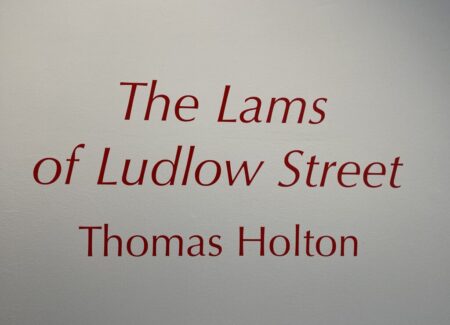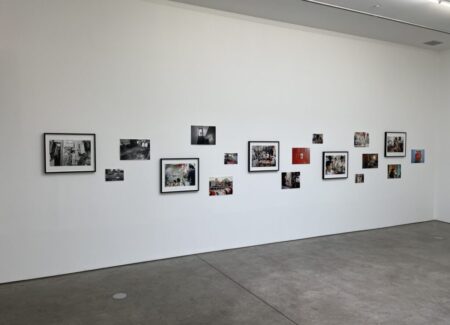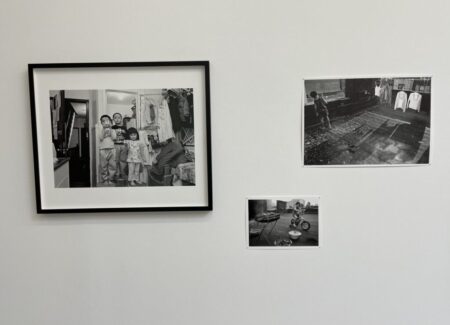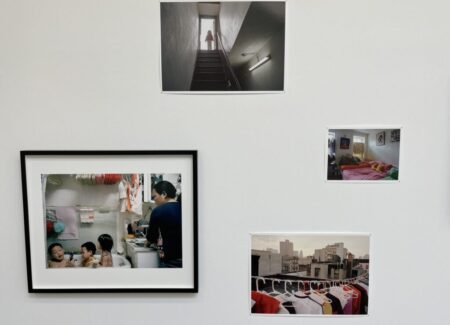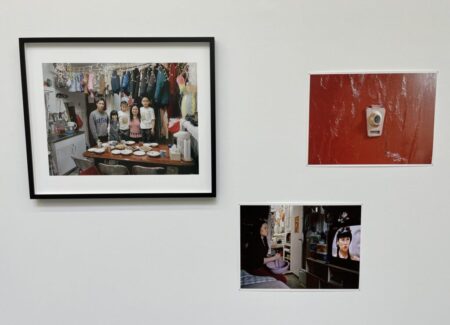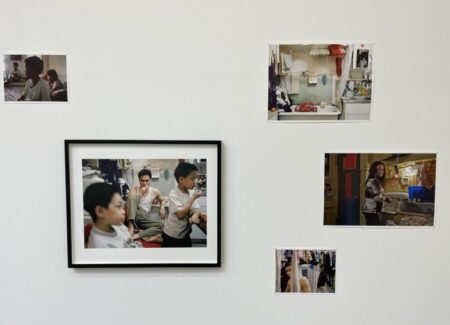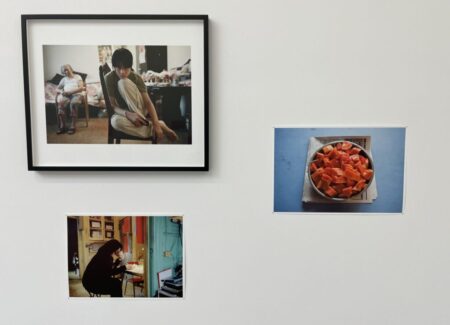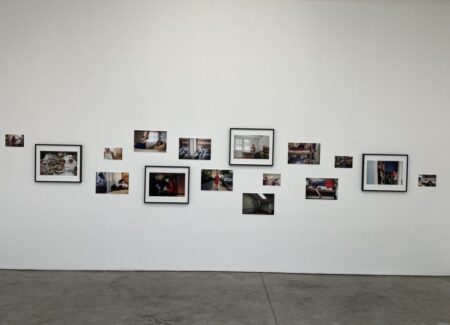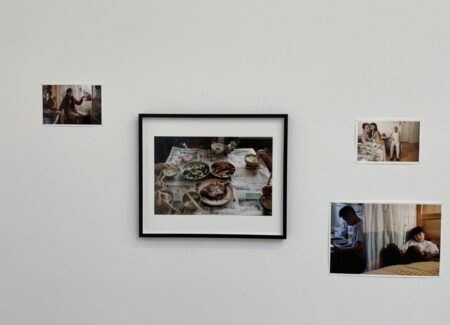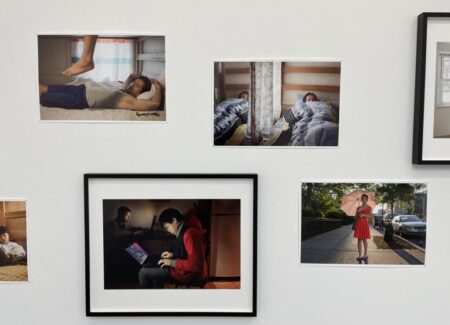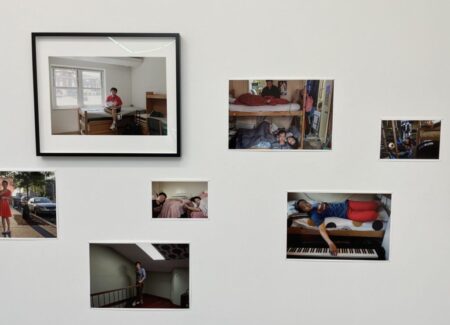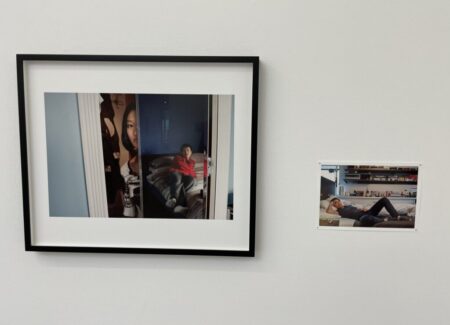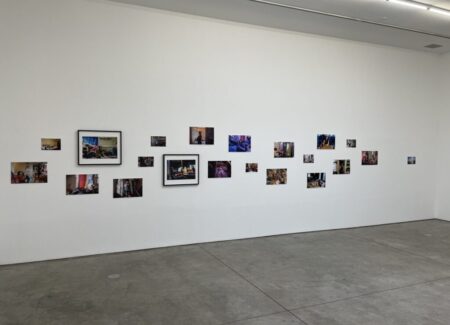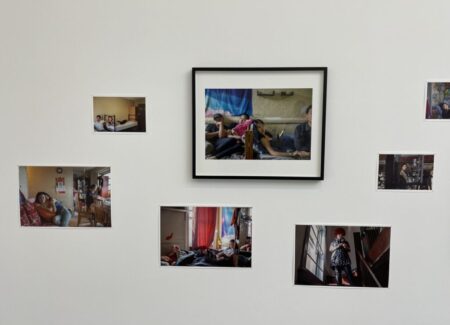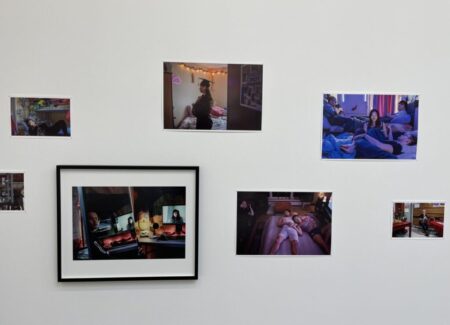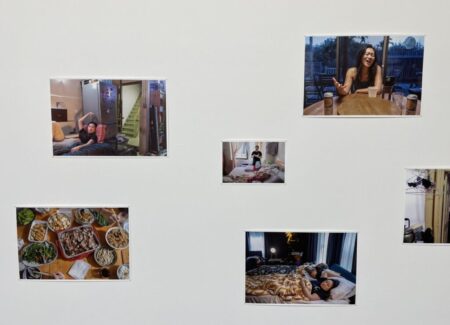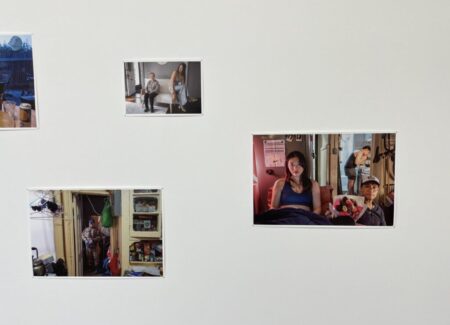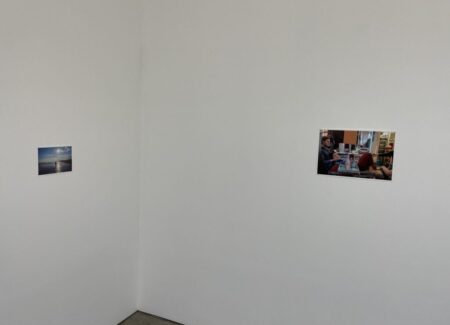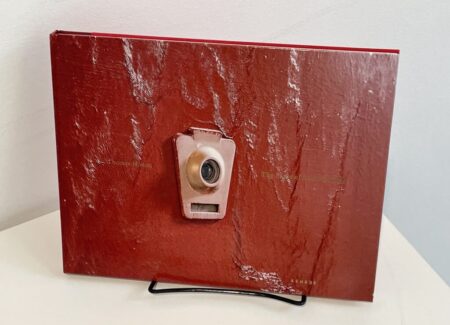JTF (just the facts): A total of 57 color and black-and-white photographs, alternately framed and unframed, and hung against white walls in the back gallery space. (Installation shots below.)
The following works are included in the show:
- 16 archival inkjet prints, 2003, 2005, 2011, 2014, 2018, 2020, 2021, 2022, 2024, 8.5×11 inches
- 31 archival inkjet prints, 2003, 2004, 2010, 2011, 2012, 2013, 2014, 2015, 2018, 2019, 2021, 2022, 2023, 2024, 2025, 13×19 inches
- 10 archival inkjet prints, 2003, 2004, 2011, 2014, 2019, 2021, 20×24 inches
A monograph of the body of work was published in 2015 by Kehrer (here). Hardcover, 28×22 cm, 96 pages, with 55 reproductions. Includes essays by Bonnie Yochelson and Charles Traub. (Cover shot below.)
Comments/Context: When we think of the notable long term portraiture projects in recent photography, where the same person or people have been consistently photographed over years and even decades, predictably most of these projects turn the camera toward family (wives, husbands, children, parents, and other extended family members) or back on the artist him or herself. These are of course ready and largely willing subjects, and generally of intimate interest to the photographer, making the likelihood of keeping the project going much higher. Ultimately, it takes dedication, methodical persistence, and a bit of luck to successfully execute such projects, which is why there are so few that have stretched out over extended periods of time.
What’s particularly fascinating about Thomas Holton’s long term project “The Lams of Ludlow Street”, which has now clocked in at more than twenty-two years and counting, is that the Lams aren’t actually Holton’s relatives, and that the project doesn’t seem to have been intended (at least initially) as a time-based portraiture study. Holton came to the project from a deeper personal impulse; born to a Chinese mother and an American father, and with relatives living in New York’s Chinatown, Holton was drawn to the neighborhood, but felt like an outsider there, disconnected from its rhythms and rituals. To come to grips with his own heritage, he began making street photographs there, and was working with University Settlement, a support organization for immigrants on the Lower East Side, when he was introduced to the Lams.
As the title of the project (and the accompanying photobook and gallery show) makes clear, the Lams lived on Ludlow Street in Chinatown, in a two room apartment on the fifth floor of an old tenement building. When Holton met them in 2003, they were a family of five living in those cramped quarters – the parents Steven and Shirley, and three kids Michael, Franklin, and Cindy. At first, he visited them once a week – hanging around, helping with chores, and slowly building trust with the family and making a few initial pictures of their daily lives. Ultimately, Holton found himself inside the extended Chinatown family he had never had, attending birthdays and other celebrations, and also being present for the evolving struggles and tensions that the family was facing.
This gallery show is organized roughly chronologically, circling the single room space clockwise, mixing black-and-white and color images in different sizes in a rough progression. Much of the first wall tracks the first few years of Holton’s engagement with the Lams, from 2003 to 2005. And while not as formally rigid as Nicholas Nixon’s study of the Brown sisters, Holton’s images were undeniably constrained by the tight environment of the Lam’s apartment (with a few images made on the roof) – there are only so many ways you can photograph two rooms, with one bedroom (with TV) and one kitchen/bathroom/dining room.
In his earliest photographs, Holton seems initially most at ease with the kids and their improvised play on the roof – they pose with passport photos, peek over the roof down to the street, and ride bikes with training wheels on the tar paper. Inside, there is more visual (and actual) chaos, with the three kids in the tub while the mother works at the stove, and ingenious storage solutions, including various poles and wires for hanging clothes, in nearly every available space near the ceilings. These realities make Holton’s frames overstuffed with visual detail, with hanging items, drying towels, and icicle lights surrounding and interrupting the hectic everyday routines. In many images, there is a sense of multiple things constantly happening all at once, with flowers draining in the tub near a pile of laundry, and faces arranged in layers at different depths, each person in the young family finding temporary room for him or herself (on a chair, near the table, watching TV) in the crowded spaces.
Holton took a break from photographing the Lams between 2005 and 2010, and as it turned out, those were tumultuous years for the family. Steven and Shirley’s marriage fell apart in 2005, leading to Steven moving out, only to return again in 2008 when the economic crisis hit. By the time Holton started making images of the family again, the family was unsettled, with people ultimately spread out and living in several places, and the kids now tweens and teenagers, the eldest Michael heading into high school. Holton’s photographs successfully capture the nuances of these challenges, including bunk beds and curtains dividing the spaces into more partially private areas, kids working on laptops, parents looking a little more weary and frazzled, and the deeper lines of strained boredom and sullen loneliness on various faces. 2014 brought more changes, with Michael headed off to college in upstate New York and Steven finding an apartment in New Jersey, so the family splintered once again, with Holton along for the ride, documenting college orientation, Steven’s empty new apartment, and the ever present visual divisions provided by mirrored doors, ladders, and bunks.
While Holton’s monograph of “The Lams of Ludlow Street” essentially ends there, the gallery show continues on, adding another intermittent decade of checking in with the family now and then. Over the next years, the spatial arrangements continue to change – Cindy goes to college, Steven moves to the Bronx, and family members then return for holidays, communal dinners, and celebrations, crowding together and sharing beds once more. The years continue to pass, the pandemic interrupts things, jobs change, Cindy graduates from college, and Michael gets married, each mini milestone (and elaborate meal spread) captured by Holton’s camera. But these small moments never devolve into something like a mundane family album; Holton is constantly playing with composition, framing, and color, and looking for the subtleties of tension and emotion that reflect the changing family relationships and dynamics. Each picture tells a story, with the physical surroundings often influencing how the lives of his small cast of individual subjects are playing out.
As seen here, “The Lams of Ludlow Street” fits neatly into a discussion of long term portraiture projects, but it resonates just as strongly with the work of various Chinese-American photographers who have explored the aspirations and sacrifices of Chinese immigrant families. Holton’s photographs easily connect back to the earlier work of Corky Lee, Chien-Chi Chang, and Michael Jang, as well as to more recent efforts by artists like Tommy Kha. In this way, Holton’s project extends beyond the Lams as a specific 21st century family, to offer a more universal sense of the Asian-American immigrant experience (particularly as lived in New York City.)
The “outsider as insider” and the “becoming one of the family” narratives that underlie Holton’s own artistic journey give this project a durable feeling of richness and intimacy. In coming to terms with his own cultural identity, he has used his picture making as a way to find nuanced connection, and in doing so, has crafted an engaging visual history of an American family. Can Holton keep it going, tracing the paths of the Lam family members as they continue onward, each building their own lives but also staying inextricably linked together? Perhaps there is a natural end to such a story, but I for one certainly hope so, as every additional picture adds to the complexity of the whole, artfully charting the many possibilities and trajectories of the American Dream.
Collector’s POV: The prints in this show are priced at $2500 and $4000 for the two largest sizes (20×24 and 30×40 inches). Holton’s work has little secondary market history at this point, so gallery retail likely remains the best option for those collectors interested in following up.
